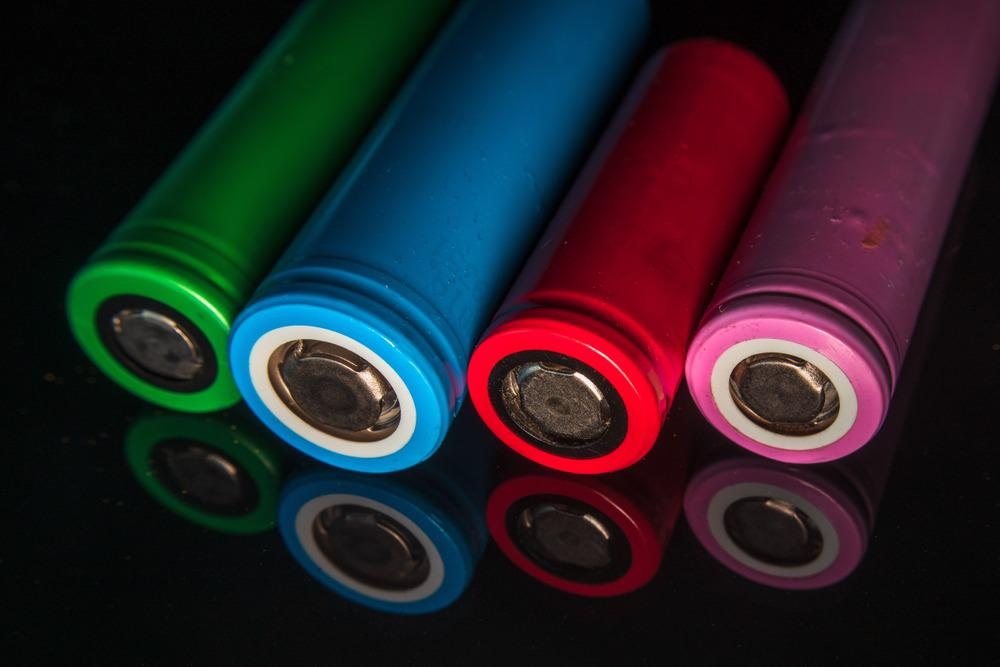In the latest advancement in the field of aqueous zinc-ion batteries (ZIBs) described in a study published in the journal ACS Publications, researchers from China developed a promising cathode material made up of layered nanorod-shaped and potassium-ion (K+)-inserted vanadium oxide (K0.54V2O5).

Study: Reversible K0.54 V2 O5 Nanorods for High-Performance Aqueous Zinc-Ion Batteries. Image Credit: DMZ001/Shutterstock.com
Owing to the improved layered spacing and ion diffusion rate, the prepared cathode exhibited excellent electrochemical performance with an initial specific capacity of 290 mAh g−1 at 0.2 A g-1, a capacity of 176 mAh g−1 over 2400 cycles at 5 A g−1, and capacity retention of 97%. The presence of K+ ion also improved the structural adaptability of the cathode against large volumetric change associated with Z2+ ion.
Performance Improvement of ZIBs
ZIB is a highly available, low-cost, and non-toxic alternative to lithium-ion batteries (LIBs). ZIBs with Zn metal as the anode exhibit promising characteristics such as a low standard electrode potential (−0.76 V vs. a standard hydrogen electrode), a high theoretical specific capacity of 820 mAh g−1, a volumetric capacity of 5855 mAh cm−3 (theoretically calculated from the density of zinc 7.134 g cm−3), and excellent stability.
However, these cathode materials are prone to collapse due to large volumetric changes during the electrochemical cycles, which leads to reduced performance, which in turn greatly hinders the practical application of ZIBs.
Furthermore, the structural stability of the cathode for the ZIB can be improved by the incorporation of hydrated vanadate and alkaline metal ions. First of all, K is low-cost and abundant. Other than that, it has a larger ionic radius (1.33 Å) than that of Zn2+ (0.74 Å) and also accelerates Zn2+ ion diffusion, which results in a higher theoretical capacity and enhanced rate capability.
The Study and Observations
In this study, researchers synthesized hydrated layered nanorod-shaped K0.54V2O5 using a hydrothermal technique.
The X-ray diffraction (XRD) pattern showed that the highest peak at 9.46° is indexed to the (001) crystal plane with a layer spacing of 9.34 Å, which was more than twice that of V2O5 (4.4 Å). Similarly, V3O7-0.32H2O had a layer spacing of 8.44 Å. Scanning electron microscopy (SEM) images revealed the layered nanorod shape of K0.54V2O5 with several micrometers of length and tens of nanometer of width. The (001) peak of K0.54V2O5 showed a minor shift from 9.46 to 9.42 after being discharged to 0.8V, indicating an increase in d-space with the decrease in voltage.
Inductively coupled plasma-optical emission spectrometry (ICP-OES) analysis showed the stoichiometric molar ratio of K to V was 0.54:2. Hence, the stoichiometric formula of the sample was denoted as K0.54V2O5. Moreover, the thermogravimetric analysis (TGA) showed the heavily bonded crystal water in V3O7·0.32H2O was 2.13%. Also, the oxidation state of V in K0.54V2O5 was less than 5+ due to the non-stoichiometry in K.
During the heating process, the sample mass slightly increased due to the presence of tetravalent vanadium ions and their further oxidation. The insertion of K+ enhanced the structural adaptability to the large volume expansion and contraction due to Zn2+ ions.
Furthermore, the capacities of K0.54V2O5 were 244, 226, 209, 201, 189, and 190 mAh g−1 at 0.2, 0.5, 1, 2, 4, and 5 A g−1, respectively. The specific capacity decreases relatively fast at 0.2 A g−1, which might be caused by the dissolution of transition-metal ions and structural changes to some electrode materials. At high current densities, the rapid Zn2+ insertion/extraction took time to reach full ionic transport equilibrium, which led Zn2+ to access more electrochemical sites, therefore achieving higher specific capacities in the subsequent cycles. It showed a capacity of 172 mAh g−1after 2400 cycles, i.e., a capacity retention of 97%.
Conclusions
In summary, the researchers in this study synthesized hydrated layered nanorod-shaped K0.54V2O5 using a hydrothermal technique. The very high layered spacing of crystal planes of K0.54V2O5 and V3O7·0.32H2O, and the insertion of K+ ion resulted in a faster Zn2+ diffusion rate and the structural adaptability to the large volume variation. Additionally, a very high initial capacity of 290 mAh g−1 under 0.2 A g−1and high capacity retention of 97% after 2400 cycles make it a promising cathode material for ZIBs.
Reference
Wu, P., Xu, T., Chen, Y., Yaopeng, C., Yang, Q., Wang, J., Liu, Y., Li, Y., Reversible K0.54 V2 O5 Nanorods for High-Performance Aqueous Zinc-Ion Batteries. ACS Applied Energy Materials, 2022. https://pubs.acs.org/doi/full/10.1021/acsaem.1c03066
Disclaimer: The views expressed here are those of the author expressed in their private capacity and do not necessarily represent the views of AZoM.com Limited T/A AZoNetwork the owner and operator of this website. This disclaimer forms part of the Terms and conditions of use of this website.